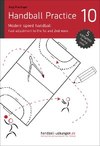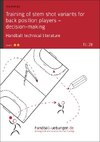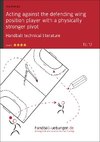Kitabı oku: «Handball Practice 10 - Modern speed handball: Fast adjustment to the 1st and 2nd wave»
Introduction
Dear reader
Thank you for choosing a book of the handball-uebungen.de training guide series.
Fast breaks are an important factor for successful handball game outcomes in modern handball. Further positive aspects include motivation of the team through quick goals in connection with demoralization of the opposing team as well as improvement of the attractiveness of the handball game itself. Quick adjustment from defense to offense play after winning the ball (or after a fast throw-off following a goal) in order to take advantage of the off-guard situation and score a goal through increased speed of play is the central objective of speed play with fast breaks.
From winning the ball and
- quickly adjusting from defense to offense play
- to initiating the first or subsequent second wave
- and a well-structured action following the second wave
- or the fast throw-off
all these fast break elements are dealt with during the following five training units.
The first two units focus on fast break initiation and the improvement of passing precision and passing decisions for a first wave as well as carrying the ball forward after gaining ball possession. The third unit focuses on the decision-making process in outnumbered situations that may be created during the first or second wave, whereas the last two units practice well-structured playing against an off-guard and passively acting defense formation.
With these five training units, the collection offers ideas and incentives for practicing the individual fast break phases and provides the opportunity to implement a comprehensive concept that involves both the first and second wave and the fast throw-off.
This book contains the following training units:
TU 1 – Improving passing precision when initiating the first wave ()
The objective of this training unit is to improve running paths, passing and the decision-making process during the first wave. After a warm-up running exercise, the subsequent short game already includes quick adjustment exercises and long passes. During the ball familiarization phase and the goalkeeper warm-up shooting, the players practice playing long passes before they combine several actions with first wave initiation in a series of shots. The closing small group exercises finally focus on making passing decisions.
TU 2 – Quick adjustment to a fast break after a defense action ( 

 )
)
The objective of this training unit is to practice the quick adjustment from defense play to fast break initiation. Following the warm-up phase with a coordination run exercise and the ball familiarization phase, the goalkeeper warm-up shooting combines a preparatory defense exercise and a series of shots for the goalkeeper. During the two subsequent defense exercises, the players practice quick adjustment from defense work to fast break countermovement. A 4-on-4 game and a sprint contest complete this training unit.
TU 3 – Improving speed play for fast break situations ( 

 )
)
The objective of this training unit is to improve free play in fast break situations. Following warm-up and a short game, the players play long passes during the ball familiarization phase which will be further developed in the goalkeeper warm-up shooting exercise. This is followed by a series of shots requiring precise passes. Afterwards, the players practice free play in outnumbered, open situations during fast breaks. A closing game with gradually increasing complexity completes this training unit.
TU 4 – Developing a well-structured second wave by implementing long crossing moves and options for further playing ( 

 )
)
The objective of this training unit is to develop a long crossing during the second wave. Following a warm-up running exercise, a short game, and a ball familiarization exercise, the players initially develop the long crossing during the goalkeeper warm-up shooting phase. In the subsequent series of shots which will be combined with a 1-on-0 fast break, the players practice the long crossing with compensation of the center back player. Defense players and the pivot are added for the two subsequent small group exercises, before the players implement the course 4-on-4 during the closing part of the training unit.
TU 5 – Step-by-step development of initial actions after a fast throw-off (TU 227) ( 

 )
)
The objective of this training unit is to develop a simple initial action after a fast throw-off. Following warm-up and a coordination run exercise, the players practice the basics during the ball familiarization phase and the goalkeeper warm-up shooting. During the three subsequent exercises, the players further develop the running and passing paths and eventually combine them in order to create an initial action. In the closing game, the players implement what they practiced before.
Publishing Information
1st English edition released on 14 Nov 2018
German original edition released on 23 Aug 2016
Published by DV Concept
Editors, design, and layout: Jörg Madinger, Elke Lackner
Proofreading and English translation: Nina-Maria Nahlenz
ISBN: 978-3-95641-236-3
This publication is listed in the catalogue of the German National Library. Please refer to http://dnb.de for bibliographic data.
The work and its components are protected by copyright. No reprinting, photomechanical reproduction, storing or processing in electronic systems without the publisher's written permission.
1. Insight into the annual schedule
Training objectives
In the training of adult teams, a coach usually will be measured based on his or her success (league position). Hence, the individual training units are strongly focused on the respective opposing team (aim of season). Winning games and making efficient use of the team’s potential are paramount.
In the training of youth teams, however, the individual development is the most important objective which has priority over success. The players should also be trained on a general basis, i.e. on each position (no positional specialization, no offense/defense specialization).
Fast breaks play an important role in both areas. Especially for youth teams with their offensively acting defense formations, playing the first wave, carrying the ball forward quickly, and adjusting to outnumbered situations during the fast break play a crucial role.
With increasing age, comprehensive fast break concepts with a well-structured second wave become more and more important.
Annual schedule
The following points should be taken into consideration when creating your annual schedule:
- How many training units do I have (do not forget vacations, holidays, and the season schedule)?
- What do I want to achieve/improve this season?
- What goals should be achieved within a given concept (of the club, the association, i.e. the German Handball Association [DHB], for example)? You can refer to the publications of the DHB for information about defense systems, individual offense/defense skills, and the expected performance of a certain age group.
- What skills does my team have (do the individual players have)? You should continuously analyze and document the skills of your team so that you can make a target-performance comparison at a regular basis.

Individual steps of the annual schedule
A handball season can be divided into the following training phases:
- Preparatory phase until the first game: This phase is suitable for improving physical fitness skills such as endurance.
- 1st part of the season until the Christmas holidays: The Christmas break should be kept in mind here.
- 2nd part of the season until the end of season.
You should then refine and elaborate these training phases step by step.
- Division of training phases into sections with part-specific objectives (monthly schedule, e.g.).
- Division into weekly schedules.
- Planning of individual training units.

Creating well-structured training units
A clear structure is important for the annual schedule as well as for the planning of the individual training units.
- Work with parts (see monthly schedule). You should work on a special topic over a certain period of time, especially in the training of youth teams. That way, you can repeat exercises and make sure the players memorize the courses.
- Each training unit should have a clear training focus. Do not mix topics within a training unit, but make sure that each exercise has a well-defined objective.
- The players are corrected in accordance with the training unit's focus (when training the defense, defense actions are corrected and pointed out).
In each individual planning phase, training units that focus on improving speed of play will play a role in one way or another. Completely new fast break concepts should be developed during the preparatory phase already, whereas decision-making processes, free play, and adjusting from defense to offense play may be improved continuously during all phases.










